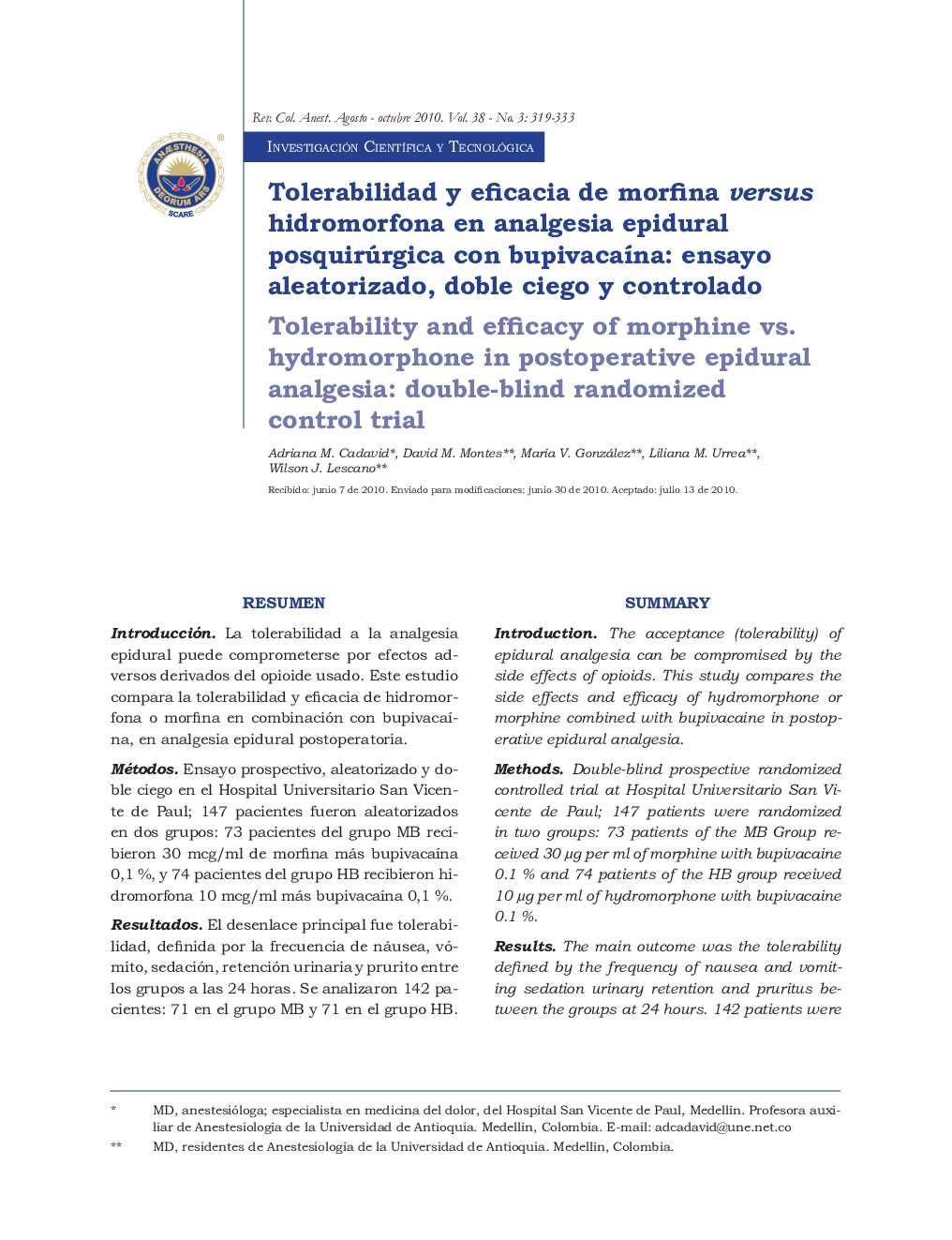| Article ID | Journal | Published Year | Pages | File Type |
|---|---|---|---|---|
| 2768122 | Revista Colombiana de Anestesiología | 2010 | 15 Pages |
RESUMENIntroducciónLa tolerabilidad a la analgesia epidural puede comprometerse por efectos adversos derivados del opioide usado. Este estudio compara la tolerabilidad y eficacia de hidromorfona o morfina en combinación con bupivacaína, en analgesia epidural postoperatoria.MétodosEnsayo prospectivo, aleatorizado y doble ciego en el Hospital Universitario San Vicente de Paul; 147 pacientes fueron aleatorizados en dos grupos: 73 pacientes del grupo MB recibieron 30 mcg/ml de morfina más bupivacaína 0,1 %, y 74 pacientes del grupo HB recibieron hidromorfona 10 mcg/ml más bupivacaína 0,1 %.ResultadosEl desenlace principal fue tolerabilidad, definida por la frecuencia de náusea, vómito, sedación, retención urinaria y prurito entre los grupos a las 24 horas. Se analizaron 142 pacientes: 71 en el grupo MB y 71 en el grupo HB. La frecuencia de náusea fue de 36,6 % y 31 %, (p = 0,54); vómito, 19,7 % y 25,4 % (p = 0,42); sedación 15,5 % y 14,1 % (p = 0,81); retención urinaria 11,3 % y 7 % (p = 0,38); y prurito 43,7 % y 31 % (p = 0,11) para los grupos MB y HB, respectivamente. Cinco pacientes fueron retirados del estudio debido a migración o desconexión del catéter. No se hallaron diferencias estadísticamente significativas entre los grupos. La escala verbal numérica (EVN) de dolor dinámico a las 24 horas fue de 3,42 (+/− 2,8) y 2,82 (+/− 2,5) para los grupos MB y HB, respectivamente (p = 0,16).ConclusiónLa escogencia entre morfina 30 mcg/ml o hidromorfona 10 mcg/ml no influye en la tolerabilidad o eficacia de esta técnica.
SUMMARYIntroductionThe acceptance (tolerability) of epidural analgesia can be compromised by the side effects of opioids. This study compares the side effects and efficacy of hydromorphone or morphine combined with bupivacaine in postoperative epidural analgesia.MethodsDouble-blind prospective randomized controlled trial at Hospital Universitario San Vicente de Paul; 147 patients were randomized in two groups: 73 patients of the MB Group received 30 μg per ml of morphine with bupivacaine 0.1 % and 74 patients of the HB group received 10 μg per ml of hydromorphone with bupivacaine 0.1 %.ResultsThe main outcome was the tolerability defined by the frequency of nausea and vomiting sedation urinary retention and pruritus between the groups at 24 hours. 142 patients were analyzed: 71 in group MB and 71 in group HB. The incidence of nausea was 36.6 % and 31 % (p = 0.54); vomiting 19.7 % and 25.4 % (p = 0.42); sedation 15.5 % and 14.1 % (p = 0.81); urinary retention 11.3 % and 7 % (p = 0.38); and pruritus 43.7 % and 31 % (p = 0.11) for groups MB and HB respectively. Five patients were excluded either because of catheter migration or disconnection. No statistically significant differences were found between the groups. The verbal numerical scale (VNS) of dynamic pain at 24 hours was 3.42 (+/− 2.8) y 2.82 (+/− 2.5) for groups MB and HB respectively (p = 0.16)ConclusionsThe choice between 30 μg per ml of morphine or 10 mcg per ml of hydromorphone does not influence the incidence of side effects or the efficacy of this technique.
